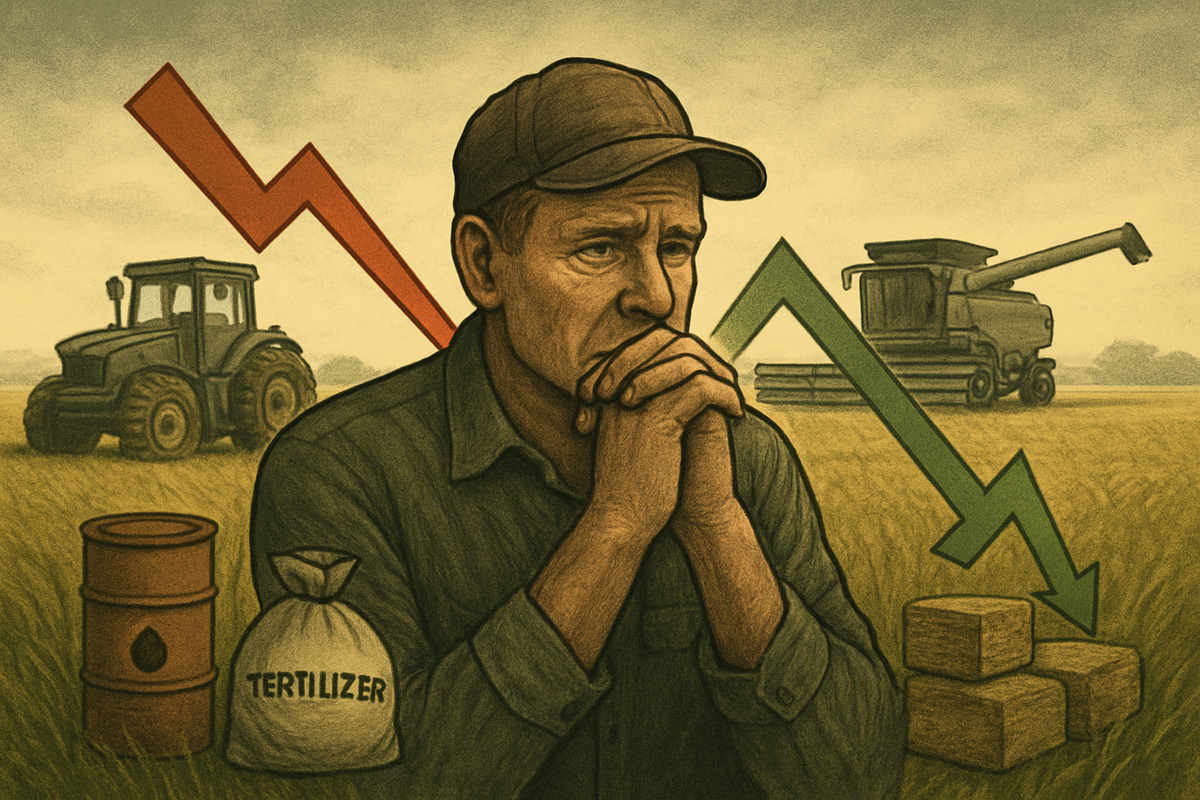
The global agricultural sector is bracing for a significant financial challenge as projections indicate a widening dislocation between farm costs and returns beyond the 2025-26 agricultural cycle. This growing disparity, often termed a "cost-price squeeze," threatens to severely impact farmer profitability and financial stability, leading to a period of heightened stress for producers worldwide. With commodity prices expected to decline or stagnate while input costs remain stubbornly high, the industry faces a critical juncture that demands strategic adaptation and potential policy interventions.
This impending financial strain is set to trigger a sharp decline in net farm income, with some forecasts predicting a substantial drop of over 20% in 2026 alone. Many major crop producers are already staring down the barrel of negative profit margins, even with strong yields. The implications extend beyond individual farms, potentially affecting the broader supply chain, food security, and rural economies. As the agricultural landscape shifts, stakeholders from policymakers to consumers will need to monitor these trends closely to understand their far-reaching consequences.
The Widening Gyre: Causes, Timeline, and Market Reactions
The projected dislocation between farm costs and returns is a complex issue rooted in a confluence of economic, geopolitical, and environmental factors. The primary driver is the diverging trajectory of agricultural commodity prices and the expenses required to produce them. After a period of elevated prices in 2021-2022, largely fueled by supply chain disruptions, strong demand, and the war in Ukraine, major commodity prices for crops like corn, soybeans, and wheat are projected to fall or remain flat in 2026 and beyond. This decline is attributed to improved global supplies, an anticipated slowdown in global economic growth, and intense competition in export markets. The World Bank forecasts a gradual decline in agricultural prices, by 1% in 2025 and 3% in 2026.
Conversely, farm input costs are expected to remain elevated or continue their upward trend. Fertilizer and chemical prices, while experiencing some temporary moderation, rebounded in late 2025 and are projected to trend higher in 2026 due to persistent supply chain issues, geopolitical tensions, and tariffs. Energy and fuel costs are anticipated to remain similar to 2025 levels or increase, while labor costs continue to climb in tight rural markets. High interest rates are also a major threat, particularly for highly leveraged operations, with interest payments projected to be substantial in 2025. Furthermore, the high cost of new machinery is forcing farmers to rely on older equipment, leading to increased repair and maintenance expenses driven by inflation in parts and service. A critical factor exacerbating this squeeze is the projected sharp decline in government support, which significantly bolstered U.S. net farm income in 2025 through ad hoc disaster assistance. These payments are expected to decrease substantially in 2026, removing a vital financial buffer.
The timeline leading up to this projected squeeze began with the initial surge in commodity prices and input costs during the pandemic and subsequent geopolitical events. While commodity prices have shown signs of cooling more recently (as of late 2025), input costs have demonstrated a "stickiness," failing to recede at the same pace. Key players and stakeholders involved include individual farmers and farm organizations (e.g., American Farm Bureau Federation), major agricultural input suppliers (e.g., Corteva Agriscience (NYSE: CTVA), Nutrien Ltd. (NYSE: NTR)), food processors (e.g., Archer-Daniels-Midland Company (NYSE: ADM)), financial institutions lending to the agricultural sector (e.g., Rabobank), and government bodies responsible for agricultural policy (e.g., USDA in the U.S.). Initial market reactions, still largely anticipatory, include heightened caution among agricultural lenders, calls from farm groups for robust support in upcoming farm bills, and a strategic shift among some producers towards cost optimization and risk management.
Winners and Losers: Corporate Impacts and Market Shifts
The projected dislocation between farm costs and returns will undoubtedly create a distinct divide between potential winners and losers within the agricultural ecosystem. Farmers, particularly those specializing in major row crops like corn, soybeans, and wheat, are squarely in the "loser" category. With negative profit margins projected for many operations, their ability to cover debt obligations, reinvest in their farms, or even sustain their livelihoods will be severely tested. Younger farmers and those with higher debt-to-asset ratios are especially vulnerable, facing increased financial stress and the potential for farm exits.
Conversely, certain segments of the agricultural supply chain might find themselves in a relatively stronger position, or at least more insulated. Companies that provide essential, high-value agricultural technologies and services aimed at efficiency and cost reduction could see increased demand. For instance, precision agriculture technology providers (e.g., Deere & Company (NYSE: DE) with its tech offerings, or specialized ag-tech startups) that can help farmers optimize input use and improve yields might experience continued growth, as farmers desperately seek ways to cut costs and maximize returns from every acre. Similarly, companies involved in the development and distribution of drought-resistant seeds or other climate-resilient agricultural solutions could see a boost as farmers look to mitigate risks.
Food processing companies and retailers (e.g., Tyson Foods, Inc. (NYSE: TSN), Walmart Inc. (NYSE: WMT)) could benefit from lower commodity prices, which would reduce their raw material costs. However, this benefit might be offset by potential disruptions in supply if farmer financial stress leads to reduced production or exits from the industry. Input suppliers, such as fertilizer and chemical companies, might continue to benefit from elevated prices for their products, contributing to the cost-price squeeze for farmers. However, if farmer profitability declines sharply, it could eventually lead to reduced demand for certain inputs, forcing these companies to adjust their pricing or product strategies. The livestock sector, particularly beef cattle, might experience more favorable conditions in the near term due to strong demand and tight supplies, offering a potential hedge for diversified agricultural businesses.
Broader Implications: Trends, Regulations, and Historical Parallels
This projected agricultural dislocation is not an isolated event but rather fits into broader industry trends characterized by increasing volatility, consolidation, and the growing influence of global economic and geopolitical forces. The trend of rising input costs against fluctuating commodity prices has been a recurring theme in agriculture, but the current projections suggest an intensification of this squeeze. It underscores the ongoing challenge for agriculture to feed a growing global population efficiently while navigating economic pressures and climate change.
The ripple effects could extend significantly. Competitors within the agricultural sector, particularly smaller, less diversified farms, may struggle to compete with larger, more efficient operations or those with stronger financial backing. Partners across the supply chain, including equipment manufacturers, seed companies, and agricultural lenders, will feel the pressure as farmer purchasing power diminishes and loan defaults potentially rise. This situation also brings significant regulatory and policy implications. The upcoming 2025 Farm Bill in the U.S. will be crucial, with farm groups lobbying for enhanced safety nets, improved crop insurance programs, and direct payment mechanisms to mitigate the financial stress. Similar policy debates are expected in other major agricultural regions globally, as governments grapple with supporting their farming communities and ensuring food security.
Historically, periods of severe cost-price squeeze have led to significant structural changes in agriculture, including increased farm consolidation, rural depopulation, and shifts in agricultural practices. The U.S. farm crisis of the 1980s, driven by high interest rates, declining land values, and low commodity prices, serves as a stark precedent, leading to widespread foreclosures and financial hardship. While the current situation has different underlying causes, the potential for similar financial distress and industry restructuring is real. The increasing global interconnectedness of markets and supply chains also means that a dislocation in one major agricultural region can have cascading effects worldwide, influencing global food prices and trade dynamics.
Navigating the Future: What Comes Next
The path forward for the agricultural sector in the face of this projected cost-price squeeze involves both immediate adjustments and long-term strategic pivots. In the short term, farmers will likely intensify their focus on cost management, scrutinizing every input and operational expense. This could mean delaying capital expenditures, optimizing fertilizer and pesticide use through precision agriculture, and seeking alternative financing options. Risk management strategies, including forward contracting and enhanced crop insurance, will become even more critical to buffer against price volatility and unexpected yield shortfalls.
In the long term, the industry may see an acceleration of trends towards diversification, value-added agriculture, and technology adoption. Farmers might explore alternative crops, direct-to-consumer sales, or niche markets to secure more stable returns. Investment in technologies that improve efficiency, reduce labor dependency, and enhance sustainability will be paramount. This could include advanced robotics, AI-driven analytics for crop management, and renewable energy solutions on farms. Collaboration across the value chain, from producers to processors and retailers, could also emerge as a key strategy to share risks and optimize resource allocation.
Potential scenarios and outcomes range from a managed adaptation, where policy support and technological innovation help cushion the blow, to a more severe downturn characterized by widespread financial distress and significant structural changes. Market opportunities may emerge for companies offering innovative solutions that genuinely help farmers reduce costs or increase revenue per acre. Challenges will include maintaining food production levels, ensuring fair prices for producers, and addressing environmental concerns amidst economic pressures. The resilience of the agricultural sector will be tested, requiring flexibility and foresight from all stakeholders.
Conclusion: A Critical Juncture for Global Agriculture
The projected growing dislocation between farm costs and returns beyond 2025-26 marks a critical juncture for global agriculture. The convergence of declining commodity prices and persistently high input costs is poised to exert immense financial pressure on farmers, leading to a significant contraction in net farm income and widespread negative profit margins for many crop producers. This "cost-price squeeze" is not merely an economic blip but a structural challenge that demands comprehensive attention and strategic responses.
The market moving forward will be characterized by increased volatility, heightened financial risk for producers, and an intensified focus on efficiency and resilience. While some segments of the agricultural supply chain, particularly those offering advanced technologies for cost reduction, may find opportunities, the core farming community faces a period of unprecedented stress. The wider implications include potential shifts in global food supply, increased calls for robust government support through policy mechanisms like the U.S. Farm Bill, and an acceleration of long-term trends towards consolidation and technological adoption within the sector.
Investors should closely watch several key indicators in the coming months: the trajectory of global commodity prices, particularly for major grains and oilseeds; the movement of key input costs such as fertilizer, fuel, and labor; the specifics of agricultural policy developments, especially the 2025 Farm Bill; and the financial health reports of major agricultural companies and farm lending institutions. The ability of the agricultural sector to navigate this impending squeeze will determine not only the livelihoods of millions of farmers but also the stability of global food systems.
This content is intended for informational purposes only and is not financial advice


















